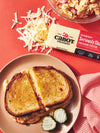
How Many Carbs in Cheese: Your Ultimate Guide to Low-Carb Dairy Choices
Cheese is often seen as a guilty pleasure, especially when you're trying to watch your carb intake. But if you're on a low-carb or keto diet, you might be wondering: how many carbs in cheese? This guide will help you understand the carb content in various cheeses, so you can make smarter choices while still enjoying your favorite dairy products.
Key Takeaways
- Most cheeses are low in carbs, making them great for low-carb diets.
- Cheddar, feta, goat cheese, gouda, and mozzarella are among the best low-carb options.
- Processed cheeses often have higher carb counts and should be avoided.
- Always check labels for carb content, especially in low-fat cheese.
- Incorporate cheese into your meals creatively for added flavor without the carbs.
Understanding Carbs in Cheese
What Are Carbs?
Carbohydrates, often shortened to "carbs", are one of the three main macro-nutrients in our diet, alongside fats and proteins. They're the body's primary source of energy. Carbs are found in a wide variety of foods, from fruits and vegetables to grains and, yes, even cheese. It's important to understand what carbs are and how they function in your body, especially if you're following a specific dietary approach like keto or simply trying to manage your carb intake.
How Carbs Affect Your Diet
Carbs have a direct impact on blood sugar levels. When you eat carbs, your body breaks them down into glucose, which then enters your bloodstream. This triggers the release of insulin, a hormone that helps glucose move from your blood into your cells for energy. The type and amount of carbs you consume can affect how quickly and dramatically your blood sugar rises. This is why understanding the net carbs in different foods is important, especially if you're managing diabetes or following a low-carb diet.
Types of Carbohydrates in Cheese
Cheese primarily contains a type of carb called lactose, which is milk sugar. The amount of lactose varies greatly depending on the type of cheese and how it's processed. Aged cheeses, for example, tend to have lower lactose content because the lactose is broken down during the aging process. Some cheeses also contain small amounts of other carbohydrates, but lactose is the main one to be aware of. The lactose content is actually directly correlated with the grams of carbs in cheese. Lactose is a disaccharide, a sugar molecule made from two monosaccharides (a single sugar molecule). Lactose is made from glucose and galactose.
When lactose is broken down, glucose is produced. Choosing a cheese with lower lactose content can help you manage your carb intake more effectively.
Here's a quick look at the carb content of some common cheeses (per 1 oz serving):
| Cheese | Carbs (g) |
|---|---|
| Blue Cheese | 0.7 |
| Brie | 0.1 |
| Cheddar | 1 |
| Cream Cheese | 1 |
| Feta | 1 |
| Goat Cheese | 0.6 |
| Gouda | 1 |
| Manchego | 0.4 |
| Mozzarella | 1 |
| Muenster | 0.3 |
Low-Carb Cheese Options
Here are some low-carb cheese options to consider.
Feta and Goat Cheese
Feta and goat cheese are great choices if you're watching your carb intake. They both have a tangy flavor that can add a lot to salads or other dishes. You can crumble feta over a simple cucumber and tomato salad. Goat cheese is also fantastic spread on some low-carb crackers. Here's a quick look at their nutritional info:
- Feta: Typically around 1g carbs per serving.
- Goat Cheese: Also around 0.6g carbs per serving.
- Both are relatively low in lactose, which is a bonus for some people.
Gouda and Manchego
Gouda and Manchego are a bit richer and have a more distinct flavor. Gouda is smooth and creamy, while Manchego has a slightly nutty taste. They're both great for snacking or adding to a cheese board. Here's what you need to know:
- Gouda: Usually less than 1g carb per one ounce serving.
- Manchego: Also less than 1 carb per one ounce serving.
- Both are good sources of fat and protein.
Mozzarella and Muenster
Mozzarella and Muenster are milder cheeses that are super versatile. Mozzarella is great in salads or melted on top of dishes, while Muenster has a slightly stronger flavor that works well in sandwiches. Here's the breakdown:
- Mozzarella: About 1g carb per serving.
- Muenster: Less than 1g carb per serving.
- Both are relatively high in moisture content.
When choosing cheeses, it's always a good idea to check the labels. Carb counts can vary slightly depending on the brand and how the cheese is processed. Also, remember that serving sizes matter! Even a low-carb cheese can add up if you eat too much of it.
Keto-Friendly Cheese Choices
Best Cheeses for Keto
Most cheeses are naturally low in carbs and high in fat, making them a great fit for a ketogenic diet. But not all cheeses are created equal, so let's talk about the best choices. Think about stocking up on keto cheese options like cheddar, mozzarella (perfect for fathead dough, a low carb dough made primarily from cheese, cream cheese, almond flour, and an egg), brie, parmesan, and havarti. These are generally safe bets and can add a ton of flavor to your meals.
Cheeses with Low Lactose
Lactose can be a sneaky carb source, and some people are more sensitive to it than others. If you're worried about lactose, aged cheeses are your friend, as the aging process reduces the lactose content. Cheeses like cheddar, parmesan, and Swiss are often well-tolerated. Also, keep an eye out for cheeses made from goat or sheep's milk, as they naturally contain less lactose than cow's milk. If you are sensitive, you can also try lactose free cheese. Cabot produces many cheeses that contain zero (0) grams of lactose, including Cheddar, Light Cheddar, Monterey Jack, Pepper Jack, and Muenster. In general, eating any aged cheese should not affect those with lactose intolerance because lactose — the major carbohydrate in milk — disappears within 3 to 4 weeks after the cheese is made.
How to Incorporate Cheese in Keto Meals
Okay, now for the fun part: how to actually eat all this cheese! Cheese is super versatile. You can use it in omelets, salads, or as a topping for your favorite keto-friendly veggies. Melt it over some broccoli or cauliflower for a quick and easy side dish. Cheese crisps are also a fantastic snack – just bake thin slices of cheese until they're crispy. And don't forget about cheese boards! Pair different cheeses with some olives, nuts, and low-carb veggies for a satisfying and social snack. Here are some ideas:
- Cheese Crisps: Bake thin slices of cheddar or parmesan until crispy.
- Stuffed Veggies: Use cream cheese to stuff celery or bell peppers.
- Cheese Sauce: Make a creamy cheese sauce for broccoli or cauliflower.
Cheese is a keto dieter's best friend. It's packed with fat, relatively low in carbs, and adds a ton of flavor to everything. Just be mindful of portion sizes and choose full-fat options whenever possible. And remember, variety is the spice of life – don't be afraid to experiment with different types of cheese to find your favorites.
High-Carb Cheeses
Some cheeses naturally have a higher carb content than others. Cottage cheese and ricotta cheese are two examples. While they're not necessarily off-limits, you need to be mindful of your portion sizes.
- Cottage Cheese: While high in protein, cottage cheese is also relatively high in carbs. Low-fat or non-fat cottage cheese often has even more carbs due to added thickeners and fruit.
- Ricotta: Ricotta can be enjoyed in small amounts, but a larger serving can easily push you over your carb limit. A 100g serving contains 7.3g of net carbs and 10.2g of fats.
It's important to remember that everyone's carb tolerance is different. What works for one person might not work for another. Pay attention to how your body responds to different cheeses and adjust your intake accordingly. Keeping track of your macros is key!
Here's a quick look at some cheeses and their approximate carb counts per serving:
| Cheese | Carbs (per serving) |
|---|---|
| Cottage Cheese | ~5g (1/2 cup) |
| Ricotta | ~9g (1/2 cup) |
| Processed Cheese | Varies |
Making Informed Dairy Choices
Choosing Quality Cheeses
When you're at the grocery store, picking out cheese can feel overwhelming. There are so many options! But, focusing on quality can make a big difference in both taste and how it fits into your diet. Look for cheeses made with simple ingredients. Fewer additives usually mean a better, more natural product. Also, consider where the cheese comes from. Local cheeses can be a great way to support local farmers and often have unique flavors you won't find anywhere else. Don't be afraid to try new things – you might discover your new favorite cheese!
Understanding Labels
Reading labels is super important, especially if you're watching your carb intake. Dairy products can sometimes have hidden sugars or additives that you wouldn't expect. Pay close attention to the serving size and the amount of carbs per serving. Also, check for added sugars, which can sneak into things like flavored yogurts or processed cheese slices. Knowing how to calculate net carbs can be really helpful. Some labels also list the type of milk used (like whole milk, skim milk, etc.), which can affect the fat content.
Creative Ways to Use Cheese
Pairing Cheese with Low-Carb Foods
Pairing cheese with the right low-carb foods can elevate your snacking game:
- Veggies: Celery, bell peppers, cucumbers, and broccoli all pair well with cheese. Try dipping baby carrots into a cheese sauce.
- Nuts and Seeds: Almonds, walnuts, pecans, and sunflower seeds offer a satisfying crunch and healthy fats. A handful of nuts with a slice of cheddar is a great afternoon snack.
- Avocado: The creamy texture of avocado complements cheese perfectly. Try topping avocado slices with crumbled feta or goat cheese.
- Olives: The salty, briny flavor of olives pairs well with many cheeses, especially feta and mozzarella. A cheese board with olives is always a hit.
Wrapping It Up
So, there you have it! Cheese can totally be part of your low-carb lifestyle, and there are plenty of options to choose from. Whether you’re a fan of creamy goat cheese or prefer the sharpness of cheddar, you can enjoy these treats without blowing your carb count. Just keep an eye on the serving sizes and pick the right types. Remember, not all cheeses are created equal, so stick to the ones that fit your diet best. Now go ahead, grab your favorite cheese, and enjoy it guilt-free!
Frequently Asked Questions
How many carbs are in cheese?
The amount of carbs in cheese varies. For example, feta has about 2 grams of carbs per ounce, while gouda has only 0.6 grams.
Is cheese good for a low-carb diet?
Yes! Many cheeses are low in carbs, making them a great choice for low-carb diets like keto.
What types of cheese are best for keto?
Cheeses like brie, gouda, and cheddar are great for keto because they have low carb counts.
Can I eat cheese if I'm lactose intolerant?
Yes, many cheeses are low in lactose, like cheddar and parmesan, so they can be enjoyed by people who are lactose intolerant.
Are processed cheeses bad for a low-carb diet?
Yes, processed cheeses often have higher carb counts, so it's best to avoid where possible.






















